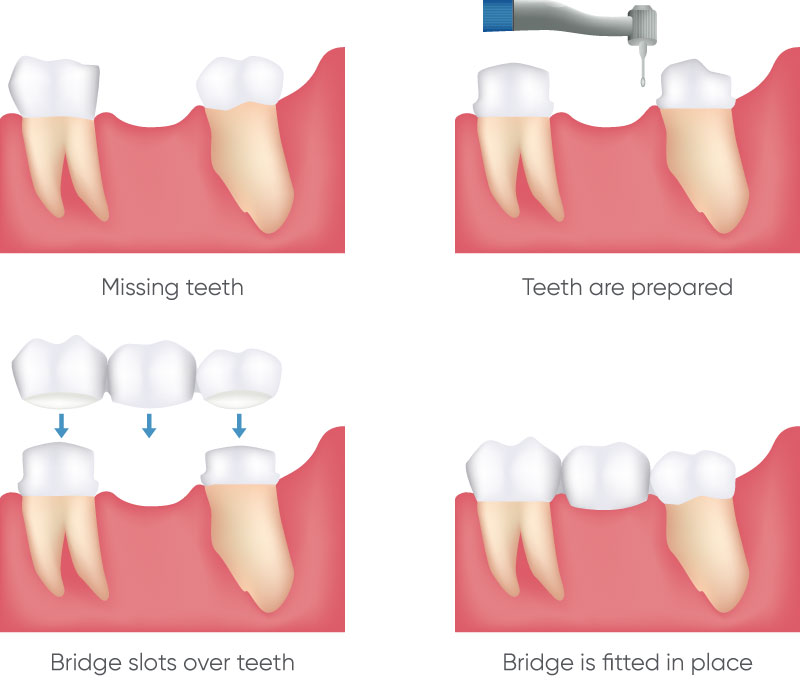Dental
Bridges
Our most recent
digital and strategy projects.
Dental Bridges That Will Improve Your Appearance and Provide Support
Dental bridges replace missing teeth and complete the appearance of your smile, while also providing much needed support for your other teeth. They are often made of porcelain because of its natural appearance and durability, but come in a variety of materials. We will recommend a treatment that is right for you. For patients who want a healthy and complete smile, dental bridges can help. Updated materials and techniques have made bridges longer lasting and more attractive than before.

When are dental crowns and bridges used?
We use dental bridges to fill the empty space left by a missing tooth. A gap in your smile can dramatically impact your appearance. A dental bridge is usually made as a single unit that is held in place by crowns on adjacent teeth. A dental bridge improves the appearance of your smile by filling the gap and prevents your surrounding teeth from shifting out of place and moving into the space left by a missing tooth, which can cause continued dental conditions.
What does this treatment involve?
A bridge can usually be placed over the course of two or three visits. After preparing your teeth to receive the required, we will take impressions to accurately represents the position, size, and shape of your natural teeth so that your restoration fits correctly. We then send your impressions to a special dental lab, where they are used to create your bridge, which usually takes about two weeks. You will be supplied with a temporary bridge to wear during production. Once complete we will see you again to fit your restoration and make any adjustments necessary. Before you leave our office, we will give you instructions for required care and maintenance. If you practise proper oral hygiene and schedule regular dental cleanings, your new bridge can last for many years.
Call to schedule a dental exam
Are you troubled by a damaged or missing tooth? Please call our office to schedule an evaluation and learn more about your options!
Any surgical or invasive procedure carries risks. Before proceeding, you should seek a second opinion from an appropriately qualified health practitioner.
Emergency Dental Appointments Available in Neutral Bay
If you are in need an emergency dentist in the Lower North Shore we are here to help. Here at Elite Dentistry in Neutral Bay, we do all we can to ensure that any urgent dental problems are dealt with quickly and efficiently. This applies regardless of whether you are an existing patient or a new patient.
Our emergency dentists are available during clinic hours to meet urgent dental needs. We can offer same day appointments for knocked out teeth, dental pain, toothache, broken filings, lost crowns, root canal pain at our Neutral Bay dental practice. Dental emergencies can be very painful, so we do all we can to provide emergency dental services promptly, as we know dental traumas can arrive any moment.
Website & Mobile Development
What types of emergency dental treatment do we offer Neutral Bay dental practice?
- Severe toothaches
- Chipped or broken tooth
- Knocked-out tooth
- Partially dislodged tooth
- Lost filling
- Lost crown
- Trapped object between teeth
- Braces repair and removal caused by broken braces or wires
- Loose brackets and bands
- Gum abscesses and swollen gums
- Soft tissue injuries
- Emergency root canal treatments
- Emergency restorative services
Arrange
an appointment
right now
Start the process of achieving a better smile today by arranging an appointment. Just call us or if out of hours use our simple request a callback from and we will call you back when we are open.
Call 02 8350 5840
Arrange
an Appointment
Right Now
Start the process of achieving a better smile today by arranging an appointment. Just call us or if out of hours use our simple request a callback from and we will call you back when we are open.

